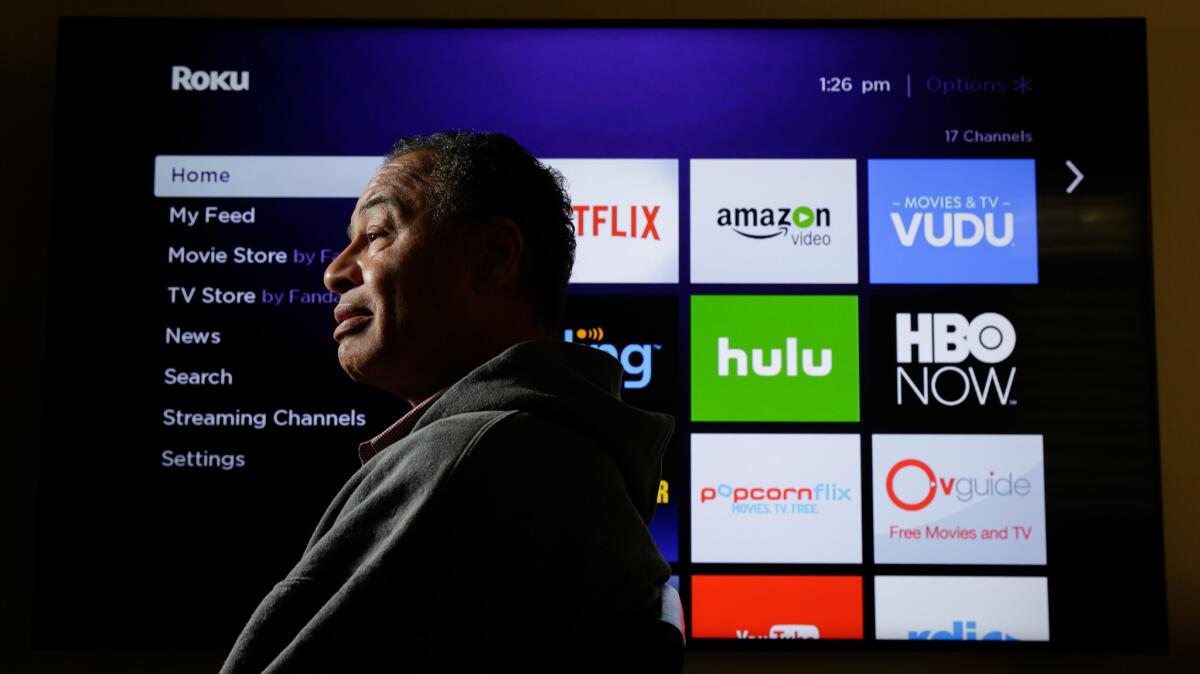Column: Cord cutting: A la carte channels looking more likely

If you talk to pay-TV insiders and analysts, the buzz these days is about so-called skinny bundles. Fewer channels. Lower monthly costs. Almost every pay-TV provider is cooking up a skinny bundle as a way to remain in the bundled-programming business.
But the times they are a-changing, and probably a whole lot faster than the pay-TV industry would like. Soon, even the thinnest bundles may be a thing of the past.
âSkinny bundles are simply a placeholder for a la carte,â said Greg Ireland, an analyst at market researcher IDC. âConsumers really want a la carte, so itâs hard to imagine we wonât get there.â
Some of the biggest names in broadcasting already are experimenting with a la carte services abroad, where theyâre less beholden to the whims of cable and satellite companies. Viacom and Disney are among those giving overseas viewers a taste of the future with online streaming services.
In this country, the pay-TV industry has been insisting for years that a la carte is a non-starter. It would cause the price of individual channels to skyrocket, industry execs have said, wiping out less-popular channels with relatively small audiences.
Those are possibilities, although I suspect a new breed of programming entrepreneurs would emerge and find ways to thrive in this more competitive environment.
What a la carte really would do is put consumers in control of the pay-TV market, ending an oligopoly that for too long has resulted in people being forced to purchase products they donât want.
Imagine if you wanted to subscribe to Sports Illustrated but Time Inc. also made you take People and Essence. Or if you wanted to read David Baldacciâs latest thriller, âThe Last Mile,â but the publishing house Hachette Book Group made you also buy âThe Marvelous Pigness of Pigs,â a faith-based guide to healthy eating.
What a la carte would do is make pay-TV channels work a whole lot harder to attract and hang on to viewers. And from where I sit, thatâs not the worst thing that could happen. Seems like a surefire way to get better programming.
It also would reclaim the business of people like Diamond Bar resident Thomas Boyd. He used to pay through the nose for a fat cable package, comprising mostly dozens of channels he never watched.
Then he cut the cable cord and signed up for the online streaming service Sling TV, which gives him 20 channels for just $20 monthly. Some of the channels he loves -- ESPN and AMC, for instance. Others still go unwatched.
âThe Freeform channel, I donât even know what that is,â Boyd, 63, told me. âLifetime -- whatâs that?â
What if his bundle was even skinnier? What if he could pay only for the handful of channels he really wanted?
âThen weâd be living in a perfect world,â Boyd replied. âYouâd be seeing me smile from ear to ear.â
Nearly half of U.S. pay-TV subscribers would prefer a la carte channels, according to a recent survey by the accounting firm PwC. Pay-TV subscribers are getting so fed up, about 20% say theyâll cut the cable cord this year.
At the moment, IDCâs Ireland said, the pay-TV business is all about a rapid shift to streaming services such as Netflix -- what the industry calls over-the-top, or OTT, services. To access these services, you need a high-speed Internet connection rather than a traditional cable or satellite subscription, plus a device to get them into your TV, such as Roku, Apple TV or a game console. A Wi-Fi-enabled smart TV will work too.
IDC found in a recent survey that 86% of cord cutters subscribe to Netflix, compared to 39% who pick Amazon Prime and 30% who join Hulu Plus. Each service, for roughly $10 a month, offers a variety of viewing options, including movies, TV shows and original content.
The heavyweight among over-the-top services is HBO Now, which costs $15 a month and provides full access to the cable channelâs content. Other premium channels, including Showtime and Starz, are available for closer to $9 monthly.
Coming later this year will be a streaming service called FilmStruck, which will feature âclassic art house, indie, foreign and cult filmsâ from TCM, the Criterion Collection and a variety of independent studios. A spokeswoman, Kendel White, told me FilmStruck âwill be competitively priced similar to other movie streaming services currently in the marketplace.â
I take that to mean âballpark to $10,â which seems to be the level at which the industry values a robust streaming service that isnât HBO. But hereâs where things get interesting.
Cord cutters might pay $10 for the likes of FilmStruck, but would they pay a similar price for AMC, home of âThe Walking Deadâ? What about the likes of FX, TNT or TBS? And then thereâs the question of how a sports fan survives in a world of pricey streaming services. How do you get all the games?
In Canada, theyâve just gotten started with a government-mandated system called âpick and pay.â Canadian pay-TV providers now must offer a base package of local and educational channels for $25 a month (about $20 in U.S. currency). Beyond that, they have to offer individual channels on an a la carte basis or skinny bundles of up to 10 channels.
By yearâs end, every provider will have to offer skinny bundles and a la carte channels. Current pricing suggests many channels will run about $3 each, and many bundles cost between $10 and $20.
Ireland has his doubts that a government-mandated a la carte system would fly here. âProgrammers would kick and scream,â he told me.
But he thinks U.S. pay-TV companies eventually will find their way to a similar place, with skinny bundles co-existing alongside popular a la carte channels.
Thus, sports fans will be able to buy a sports bundle, or entertainment-focused viewers will be able to purchase a bundle containing TNT and TBS. Meanwhile, people with more limited viewing needs could get by with, say, HBO and Amazon Prime, plus an indoor antenna for picking up local channels. Thatâs how I do it.
The exciting thing is that, after declaring over and over that there was no way weâd ever see an end to expensive bundles of hundreds of channels, the pay-TV industry is moving toward a new business model based on giving people what they want. That sound you hear is Boyd over in Diamond Bar going, âWoo-hoo!â
The only question is how much things should cost. âAt this point, everything is relative to HBO,â Ireland said.
OK, fine. The really good stuff costs $15 a month. Everything else falls into place somewhere below that level.
Thatâs a start.
See more of our top stories on Facebook >>
MORE CONSUMER CONFIDENTIAL
A pain-in-the-neck change from organizers of the âOldchellaâ concert
The date on the milk carton says itâs expired, but is it?
Banks likely to sue to deny consumers their right to sue
David Lazarusâ column runs Tuesdays and Fridays. He also can be seen daily on KTLA-TV Channel 5 and followed on Twitter @Davidlaz. Send your tips or feedback to [email protected].
More to Read
The biggest entertainment stories
Get our big stories about Hollywood, film, television, music, arts, culture and more right in your inbox as soon as they publish.
You may occasionally receive promotional content from the Los Angeles Times.











